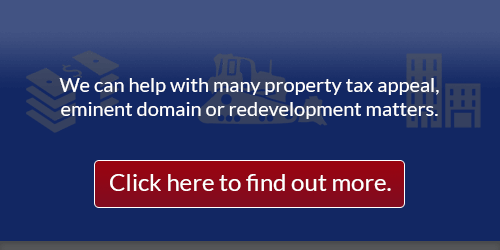Inverse Condemnation vs Eminent Domain: What New Jersey Property Owners Need to Know
Understanding the differences between inverse condemnation and eminent domain is crucial for property owners, especially in New Jersey. Inverse condemnation vs. eminent domain involves distinct legal processes and implications. This blog post will delve into these differences, providing insights into how each impacts property rights and what property owners in New Jersey need to know.
What is Eminent Domain?

Eminent domain, also known as condemnation, is the power of the government to take private property for public use, provided that just compensation is paid to the property owner. This power is derived from the Takings Clause of the Fifth Amendment of the U.S. Constitution. In New Jersey, the Eminent Domain Act of 1971 governs these proceedings, ensuring that property owners receive fair compensation for their land.
Understanding Inverse Condemnation
Inverse condemnation occurs when the government takes or damages private property without following the formal eminent domain process. In such cases, the property owner must initiate legal action to seek compensation. This often involves proving that the government’s actions have significantly diminished the property’s value or usability.
Key Differences Between Inverse Condemnation and Eminent Domain
- Initiation: Eminent domain is initiated by the government, while the property owner initiates inverse condemnation.
- Process: Eminent domain follows a formal legal process with predefined steps, whereas inverse condemnation requires the property owner to prove the government’s liability.
- Compensation: In both cases, the property owner is entitled to just compensation, but the burden of proof in inverse condemnation lies with the property owner.
Historical Context of Inverse Condemnation
Inverse condemnation is a legal concept that evolved to protect property owners when their property is effectively taken or damaged by the government without formal condemnation proceedings. This remedy allows property owners to seek just compensation under the Fifth Amendment, which mandates that private property cannot be taken for public use without just compensation.
The roots of inverse condemnation can be traced back to early 20th-century cases where courts recognized the need to protect property owners from government actions that, while not constituting formal takings, still deprived owners of the beneficial use of their property. Over time, the doctrine expanded to cover various forms of government interference, including physical invasions and regulatory actions that significantly impair property value.
Landmark Cases That Shaped the Concept
Several landmark cases have been pivotal in shaping inverse condemnation law:
- United States v. Causby (1946): This case established that low-flying military aircraft that disrupted the use of private property could constitute a taking, even without physical invasion.
- Penn Central Transportation Co. v. New York City (1978): The Supreme Court introduced a balancing test to determine whether a regulatory action constitutes a taking, considering factors like economic impact and interference with investment-backed expectations.
- Lucas v. South Carolina Coastal Council (1992): The Court held that regulations depriving a property of all economically viable use could be considered a taking, requiring compensation.
- Knick v. Township of Scott (2019): This recent decision allowed property owners to bring federal takings claims directly in federal court without first seeking compensation through state courts.
These cases have collectively broadened the scope of inverse condemnation, ensuring that property owners have a robust mechanism to seek redress when government actions infringe upon their property rights.
Inverse Condemnation in New Jersey
In New Jersey, inverse condemnation claims are governed by state-specific statutes and case law. The New Jersey Constitution, like the U.S. Constitution, protects property owners from uncompensated takings. The primary statutory framework for eminent domain in New Jersey is the Eminent Domain Act of 1971 (N.J.S.A. 20:3-1 et seq.), which outlines the procedures for formal condemnation.
However, when the government takes or damages property without following these procedures, property owners can file an inverse condemnation claim. New Jersey courts have recognized inverse condemnation as a viable legal remedy, allowing property owners to seek compensation when government actions result in a de facto taking.
Unique Aspects of Inverse Condemnation in New Jersey
- Regulatory Takings: New Jersey courts have been particularly attentive to regulatory takings, where government regulations significantly impair property value or use. Property owners can challenge such regulations under inverse condemnation if they effectively deprive the owner of all beneficial uses of the property.
- Statute of Limitations: Inverse condemnation claims in New Jersey must be filed within a specific timeframe. For instance, the case of 546 OG, LLC v. Edgewater highlighted the importance of timely filing, as the court dismissed the claim for being “grossly out of time” nine years after the alleged taking.
- Local Redevelopment and Housing Law (NJLRHL): This law allows municipalities to designate areas for redevelopment, which can lead to inverse condemnation claims if property owners believe the designation and subsequent actions constitute a taking without just compensation.
Common Scenarios Leading to Inverse Condemnation Claims
Inverse condemnation occurs when a government action effectively takes or damages private property without formally invoking eminent domain. Here are some common scenarios where inverse condemnation claims might arise, particularly relevant to New Jersey property owners:
- Regulatory Takings: This is one of the most common forms of inverse condemnation. It occurs when government regulations, such as zoning laws or environmental restrictions, severely limit the use or value of private property.
- For example, a New Jersey municipality enacts a zoning ordinance that prohibits any development on a property. The owner may file an inverse condemnation claim, arguing that the regulation has deprived them of all economically viable use of their land.
- Physical Occupations: Sometimes, government entities or their contractors may physically occupy private property without proper authorization. This could include installing utility lines, pipelines, or other infrastructure.
- In New Jersey, if a local government installs a sewer line across private property without obtaining an easement, the property owner could seek compensation through an inverse condemnation claim.
- Flooding and Water Damage: Government projects that alter water flow and result in flooding or water damage to private property can lead to inverse condemnation claims.
- For instance, if a New Jersey town constructs a drainage system that causes frequent flooding of a homeowner’s basement, the homeowner may have grounds for an inverse condemnation action.
- Noise and Environmental Pollution: Government actions that result in excessive noise, pollution, or other environmental impacts can also constitute a taking.
- An example might be the expansion of a New Jersey airport that leads to unbearable noise levels for nearby residents, effectively making their homes uninhabitable.
- Denial of Permits: When a government entity unreasonably denies permits necessary for the development or use of property, it can lead to an inverse condemnation claim.
- For example, if a New Jersey property owner is repeatedly denied building permits for arbitrary reasons, they might argue that this denial has effectively taken their property.
The Process of Filing an Inverse Condemnation Claim
Filing an inverse condemnation claim involves several steps, and it differs significantly from the eminent domain process.
Here’s an outline of the steps involved, with a focus on New Jersey:
- Identify the Taking: The property owner must first identify the government action that has resulted in a taking. This could be a regulation, physical occupation, or other government activities that have deprived the owner of the use or value of their property.
- Gather Evidence: The property owner needs to gather evidence demonstrating the impact of the government action on their property. This could include expert testimony, property appraisals, and documentation of the government action.
- File a Complaint: The property owner must file a complaint in the appropriate court. In New Jersey, inverse condemnation cases are typically brought in state trial courts. The complaint should detail the government action and its impact on the property, and assert that the action constitutes a taking without just compensation.
- Pre-Trial Motions and Discovery: Both parties will engage in pre-trial motions and discovery. This phase involves exchanging evidence, deposing witnesses, and building the case. The government may file motions to dismiss the claim, arguing that no taking has occurred.
- Trial: If the case proceeds to trial, the court will first determine whether a taking has occurred. This is often a complex factual inquiry. If the court finds that a taking has occurred, the case will move to the damages phase, where the amount of just compensation will be determined.
- Appeals: Either party may appeal the trial court’s decision. In New Jersey, appeals are typically heard by the Appellate Division of the Superior Court.
Contrast with Eminent Domain Process
- Initiation: In eminent domain, the government initiates the process by formally declaring a taking and offering compensation. In inverse condemnation, the property owner initiates the action, arguing that a taking has occurred without proper compensation.
- Burden of Proof: In eminent domain, the government must justify the taking and the amount of compensation. In inverse condemnation, the property owner bears the burden of proving that a taking has occurred and that compensation is due.
- Procedure: Eminent domain follows a well-defined statutory process, including public hearings and formal offers of compensation. Inverse condemnation is more adversarial, often involving litigation to establish that a taking has occurred.
Compensation in Inverse Condemnation vs. Eminent Domain Cases
In both inverse condemnation and eminent domain cases, the central issue is determining the amount of just compensation owed to the property owner. However, the processes and methodologies for determining compensation can differ significantly between the two.
Eminent Domain: In eminent domain cases, the government initiates the process and is required to provide just compensation to the property owner. The compensation is typically determined based on the fair market value of the property at the time of the taking. This value is assessed using one or more of the following methods:
- Market Approach: This method involves comparing the property with similar properties that have recently been sold in the same area.
- Income Approach: Used for income-generating properties, this method calculates the present value of future income streams generated by the property.
- Cost Approach: This method estimates the cost to replace or reproduce the property, minus depreciation.
In New Jersey, the Eminent Domain Act of 1971 outlines the procedures for determining just compensation, including the appointment of commissioners to assess the value and the possibility of a jury trial if either party contests the commissioners’ award.
Inverse Condemnation: In inverse condemnation cases, the property owner initiates the action, claiming that the government’s actions have effectively taken their property without formal condemnation proceedings. The burden of proof lies with the property owner to demonstrate that a taking has occurred. Compensation in inverse condemnation cases is also based on the fair market value of the property, but the process to determine this can be more contentious and complex. The property owner must provide evidence of the property’s value and the extent of the loss caused by the government’s actions.
Differences in Compensation Methods
While both types of cases aim to provide fair market value compensation, the methods and challenges can vary:
- Initiation and Burden of Proof: In eminent domain, the government initiates the process and must justify the compensation offered. In inverse condemnation, the property owner must prove that a taking has occurred and substantiate their claim for compensation.
- Process Complexity: Eminent domain follows a structured legal process with predefined steps, whereas inverse condemnation often involves more complex litigation to establish that a taking has occurred.
- Types of Takings: Eminent domain typically involves physical takings, while inverse condemnation can involve both physical and regulatory takings. Regulatory takings, where government regulations severely restrict property use, can be particularly challenging to quantify in terms of compensation.
Future Trends in Inverse Condemnation Law
As land use regulations and government actions continue to evolve, several trends and potential changes could impact inverse condemnation law:
- Increased Regulatory Takings Claims: With growing environmental regulations and zoning laws, property owners may increasingly file inverse condemnation claims when these regulations significantly impair property use or value. New Jersey, with its stringent environmental laws, could see a rise in such claims.
- Technological Impacts: Advances in technology, such as the expansion of infrastructure for renewable energy and telecommunications, may lead to new types of inverse condemnation claims. For example, the installation of 5G towers or solar farms could result in claims if they adversely affect property values.
Impact on New Jersey Property Owners
New Jersey property owners should be aware of several key factors that could influence inverse condemnation claims in the future:
- Environmental Regulations: New Jersey’s strong environmental protections, such as the Highlands Act and Coastal Area Facility Review Act (CAFRA), may lead to more regulatory takings claims. Property owners affected by these regulations might argue that they have been deprived of economically viable use of their land.
- Judicial Trends: Recent court decisions, both at the state and federal levels, could shape the landscape of inverse condemnation law. For instance, the U.S. Supreme Court’s decision in Knick v. Township of Scott has made it easier for property owners to bring federal takings claims directly in federal court, bypassing state court requirements.
- Legislative Changes: Potential legislative changes at the state level could also impact inverse condemnation claims. New laws or amendments to existing statutes could either broaden or restrict the circumstances under which property owners can seek compensation.
Conclusion
The Pennsylvania Supreme Court’s decision in Hughes v. UGI Storage Co., et al. highlights the complexities of inverse condemnation vs. eminent domain. The ruling clarified that specific eminent domain authority is not required for liability in inverse condemnation, impacting property owners’ rights.
In eminent domain, the government must provide fair market value compensation through a structured process. In inverse condemnation, property owners must prove a taking and substantiate their compensation claims, often through complex litigation. Changes in regulations, technology, and judicial trends could affect inverse condemnation claims. New Jersey property owners should stay informed to protect their rights and ensure fair compensation. Understanding the nuances of inverse condemnation vs. eminent domain is crucial for property owners. Being well-informed helps navigate legal challenges and secure deserved compensation.
Protect Your Property Rights Today
Navigating the complexities of inverse condemnation vs. eminent domain can be challenging, especially with evolving laws and regulations. We specialize in eminent domain cases in New Jersey and are dedicated to ensuring you receive fair compensation and protection under the law. Contact us today for a consultation and safeguard your property rights.










